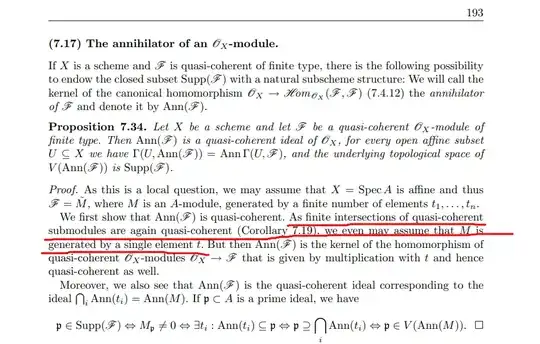I’m reading Görtz–Wedhorn’s Algebraic Geometry, proof of the Proposition 7.34, and some question arises.
Let $X$ be a scheme and $\mathcal{F}$ a quasi-coherent module of finite type. Define the annihilator $\newcommand{\Ann}{\operatorname{Ann}} \Ann \mathcal{F}$ of $\mathcal{F}$ as the kernel of the canonical homomorphism $\newcommand{\OX}{\mathcal{O}_X}\OX \to \mathcal{H}\mathrm{om}_{\OX}(\mathcal{F}, \mathcal{F})$ (Görtz–Wedhorn, 7.2.12, page 193). By Annihilator of a coherent sheaf, on affine subsets., for each open subset $U$ of $X$, $$ \Ann(\mathcal{F})(U) := \{f \in \OX(U) \mid \forall x \in U, \forall m_x ∈ F_x, f_x \cdot m_x=0\} \,. $$
Now let $X := \operatorname{Spec}A$ be an affine scheme and let $\mathcal{F} = \tilde{M}$ be a quasi-coherent module, where $M$ is an $A$-module generated by a finite number of elements $t_1, \dotsc, t_n$. Let $M_i := \langle t_i \rangle_A$ (the $A$-module generated by the $t_i$).
Question : Then, $$ \bigcap_i \Ann \tilde{(M_i)} = \Ann \tilde{M} \,? $$
Here, the intersection $\bigcap_i \mathcal{F}_i$ of a family ($\mathcal{F}_i)_{i \in I}$ of $\OX$-submodules of $\mathcal{F}$ is defined as the kernel of the canonical homomorphism $\mathcal{F} \to \prod_{i \in I} \mathcal{F} / \mathcal{F}_i$ (Görtz–Wedhorn, page 174). So, $$ \bigcap_i \Ann \tilde{M_i} := \ker\biggl( \OX \xrightarrow{\psi} \prod_{i=1}^n \OX / \Ann\tilde{M_i} \biggr) \,. $$
My first attempt is, for each affine open $U \subset X$, I am trying to show that $\bigcap_i \Ann \tilde{(M_i)}(U) = \Ann \tilde{M}(U)$.
$\subseteq$: Let $s \in \bigcap_i \Ann \tilde{(M_i)}(U)$. To show $s\in \Ann \tilde{M}(U)$, as above remark, we must show that for each $x \in U$ and $m_x \in M_x = M_{p_x}$, it follows that $s_x \cdot m_x = 0$.
We have that $\psi_U(s) = 0$. This means that $\psi_{U,i}(s) \in (\OX / \Ann \tilde{M_i})(U)$ is zero for all $i$.
- Case 1: $(\OX / \Ann \tilde{M_i})(U) = \OX(U) / (\Ann \tilde{M_i})(U)$. In this case, \begin{align*} \psi_U(s) &= ( \psi_{U,1}(s), \dotsc, \psi_{U,n}(s) ) \\ &= ( s + \Ann(\tilde{M_1})(U), \dotsc, s + \Ann(\tilde{M_n})(U) ) \\ &= (0, 0, \dotsc ,0) \,. \end{align*}
So, $s \in \Ann(\tilde{M_i})(U)$ for all $i$. Again, by the above remark, this means that “for all $x \in U$ and $n_x \in (\tilde{M_i})_x = M_{i, p_x}$, it follows that $s_x \cdot n_x =0$ for all $i$”.
And this is equivalent to “for all $x \in U$ and $m_x \in M_{p_x}$, it follows that $s_x \cdot m_x = 0$”, which is our desired result.
$\supseteq$ : Similar argument (?), maybe reversing direction of deduction.
An issue that makes me difficult is, since $U \mapsto \mathcal{F}(U) / \mathcal{G}(U)$ ($\mathcal{G}$ is an $\OX$-submodule of $\mathcal{F}$) is not sheaf in general, Case 1) does not always hold. Perhaps, assuming that each $\Ann M_i$ is quasi-coherent, Case 1) holds? Perhaps, in general, the following is true?
Let $\mathcal{G} \subseteq \mathcal{F}$ be quasi-coherent sheaves on a scheme $X$. Then for each affine open $U := \operatorname{Spec} B \subset X$, $(\mathcal{F} / \mathcal{G})(U) \cong \mathcal{F}(U) / \mathcal{G}(U)$?
I found an associated question Quotient, Tensor Quasicoherent Sheaves on Affine Open Subsets and do not understand completely well. Can we provide a more explicit proof for above claim?
C.f. More and more think about sheafification, it seems that situations becomes more complicated. Is there method to handle this problem? Is there a way to bypass considering sheafification? Brutal force argument is needed? Can anyone help? I would like to learn how to handle an issue that maybe involves sheafification.
EDIT: Further Progress! I’ve been trying to prove the above claim, based on the above linked question. Let me write my own proof:
I think that one of key point to prove the above claim is using the next theorem:
Theorem: Let $\mathcal{F}$ be a sheaf and $\mathcal{G}$ be a presheaf and $\mathcal{B}$ be a topological basis of $X$. If $\mathcal{F}(U) = \mathcal{G}(U)$ for all $U \in \mathcal{B}$, then $\mathcal{F} = \mathcal{G}^{\dagger}$ (the sheafification of $\mathcal{G}$).
Let’s go back to the above claim. First, note that $\{ D(f) \}_{f \in B}$ forms a basis for $U := \operatorname{Spec} B$. We show that for each $D(f)$, $$ (\mathcal{F} / \mathcal{G})^{\mathrm{pre}}|_U( D(f) ) = \widetilde{(\mathcal{F}(U) / \mathcal{G}(U))}( D(f) ) $$ (where $\widetilde{(\mathcal{F}(U) / \mathcal{G}(U))}$ is the associated $\mathcal{O}_U$-module). This is true since \begin{align*} (\mathcal{F} / \mathcal{G})^{\mathrm{pre}}|_U( D(f) ) &= (\mathcal{F} / \mathcal{G})^{\mathrm{pre}}( D(f) ) \\ &:= \mathcal{F}(D(f)) / \mathcal{G}(D(f)) \\ &= \mathcal{F}(U)_f / \mathcal{G}(U)_f \\ &= (\mathcal{F}(U) / \mathcal{G}(U))_f \\ &=: \widetilde{(\mathcal{F}(U) / \mathcal{G}(U))}(D(f)) \,. \end{align*} (The third equality is by the quasi-coherence of the $\mathcal{F}$ and $\mathcal{G}$ (Görtz–Wedhorn, Theorem 7.16-(iv)) and the fourth equality is by the fact that “localization commutes with quotient of modules”.)
Second, so, by the above theorem, $\widetilde{(\mathcal{F}(U) / \mathcal{G}(U))} = ((\mathcal{F} / \mathcal{G})^{\mathrm{pre}}|_U )^{\dagger} = (\mathcal{F} / \mathcal{G})|_U$ (sheafification commutes with restriction).
So, third, we have that $$ (\mathcal{F} / \mathcal{G})(U) = (\mathcal{F} / \mathcal{G})|_U(U) = \widetilde{(\mathcal{F}(U) / \mathcal{G}(U))}(U) = \mathcal{F}(U) / \mathcal{G}(U) \,. $$
Is my argument correct? Are there any parts that I made mistake? Can anyone see?
C.f. This question originates from following proof of the Görtz–Wedhorn, Proposition 7.24:
 Why is the underlined statement true? If our question is true, then since finite intersections of quasi-coherent submodules is again quasi-coherent, is suffices to show that each $\Ann \tilde{M_i}$ is quasi-coherent; i.e., we may assume that $M$ is generated by single element.
Why is the underlined statement true? If our question is true, then since finite intersections of quasi-coherent submodules is again quasi-coherent, is suffices to show that each $\Ann \tilde{M_i}$ is quasi-coherent; i.e., we may assume that $M$ is generated by single element.